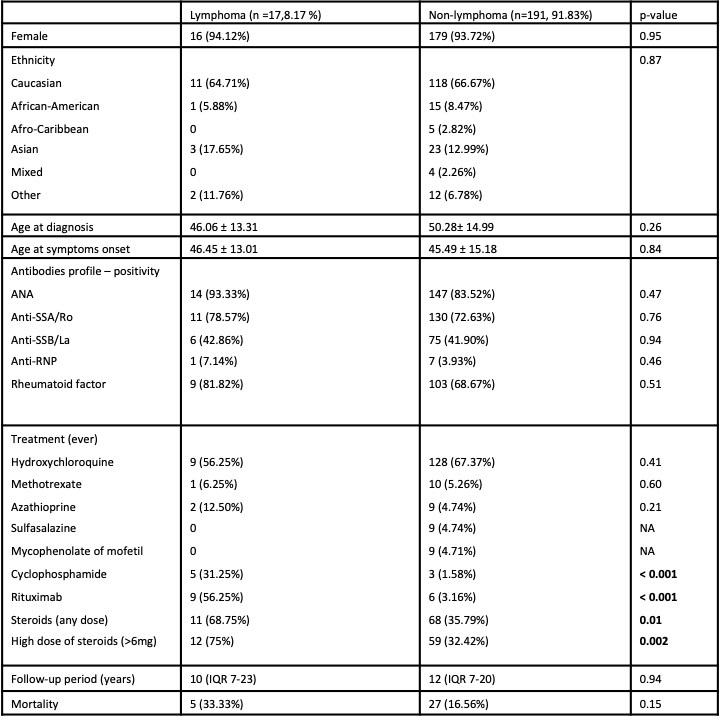Session Information
Session Type: Poster Session C
Session Time: 10:30AM-12:30PM
Background/Purpose: Primary Sjogren Syndrome (pSS) is an autoimmune disease affecting primarily exocrine glands. Over a quarter of patients have systemic involvement, which includes the development of lymphoma. While two scores were developed to assess overall damage in pSS, neither the Sjogren Syndrome Disease Damage Index (SSDDI) nor the Sjogren Syndrome Damage Index (SSDI) have been utilised as potential predictors for this complication. The aim of this study was to evaluate both scores as predictors of lymphoma in pSS.
Methods: Single center retrospective analysis of a pSS cohort (2016 ACR/EULAR criteria) followed-up for 42 years in a tertiary hospital. We considered all diagnosis of lymphoma regardless the location and immunophenotype. Patients were assessed for demographic factors, serological profile, management and mortality. Damage was assessed using the SSDDI and the SSDI beginning at disease diagnosis. Early damage was considered if it occurred in the first year after diagnosis, while early damage increase was assumed when there was an increase of at least one point of damage in the first 5 years. Categorical and continuous variables were compared using Chi-square and Student’s t test when appropriate. Cox proportional hazard models were used to assess hazard ratios for significant covariates related to the occurrence of lymphoma. A p-value < 0.05 was considered statistically significant.
Results: A total of 208 patients with pSS were followed-up for 14.1 ± 9.2 years. Most patients were women (93.8%) and Caucasian (66.5%). Seventeen patients (8.2%) developed lymphoma. The diagnosis of lymphoma occurred at an average of 7.4 ± 7.0 years after pSS diagnosis. Sex, ethnicity, age at diagnosis and disease onset, and serological profile did not differ between patients with or without lymphoma (Table 1). Compared to patients who did not developed lymphoma, those who did were more frequently prescribed cyclophosphamide (31.3% vs 1.6%, p< 0.001), rituximab (56.3% vs 3.2%, p< 0.001) and steroids (68.8% vs 35.8%, p 0.01), including high doses of steroids (75.0% vs 32.4%, p 0.002). Five patients in the lymphoma group died (33.3%), two of them due to this condition. Damage developed in 165 (79.3%) and 177 (85.1%) of patients using the SSDDI and SSDI scores, respectively. Patients with lymphoma had significantly higher cumulative SSDDI (7.7 ± 2.0 vs. 2.0 ± 1.8; p< 0.001) and SSDI (4.0 ± 2.2 vs. 2.0 ± 1.6; p< 0.001) scores compared to patients without lymphoma. The prevalence of early damage was similar in patients with and without lymphoma (Table 2). However, early damage increase predicted the development of lymphoma using the SSDDI (per one-unit increase HR 1.6, 95% CI 1.3-2) and the SSDI (per one-unit increase HR 2.0, 95% CI 1.3-3) scores. Both damage variation (SSDDI: per one-unit increase HR 1.5, 95% CI 1.3-1.7; SSDI: per one-unit increase HR 1.4, 95% CI 1.2-1.7) and the cumulative score (SSDDI: per one unit increase HR 1.7, 95% CI 1.5-2; SSDI: per one-unit increase HR 1.5, 95% CI 1.2-1.8) were also associated with an increased risk for lymphoma.
Conclusion: Cumulative and evolving damage in the first years of disease should raise concern about the possible development of lymphoma in patients with pSS.
To cite this abstract in AMA style:
Abrantes A, Gaspar P, Isenberg D. Damage Accrual Predicts the Development of Lymphoma in Primary Sjogren’s Syndrome [abstract]. Arthritis Rheumatol. 2024; 76 (suppl 9). https://acrabstracts.org/abstract/damage-accrual-predicts-the-development-of-lymphoma-in-primary-sjogrens-syndrome/. Accessed .« Back to ACR Convergence 2024
ACR Meeting Abstracts - https://acrabstracts.org/abstract/damage-accrual-predicts-the-development-of-lymphoma-in-primary-sjogrens-syndrome/


